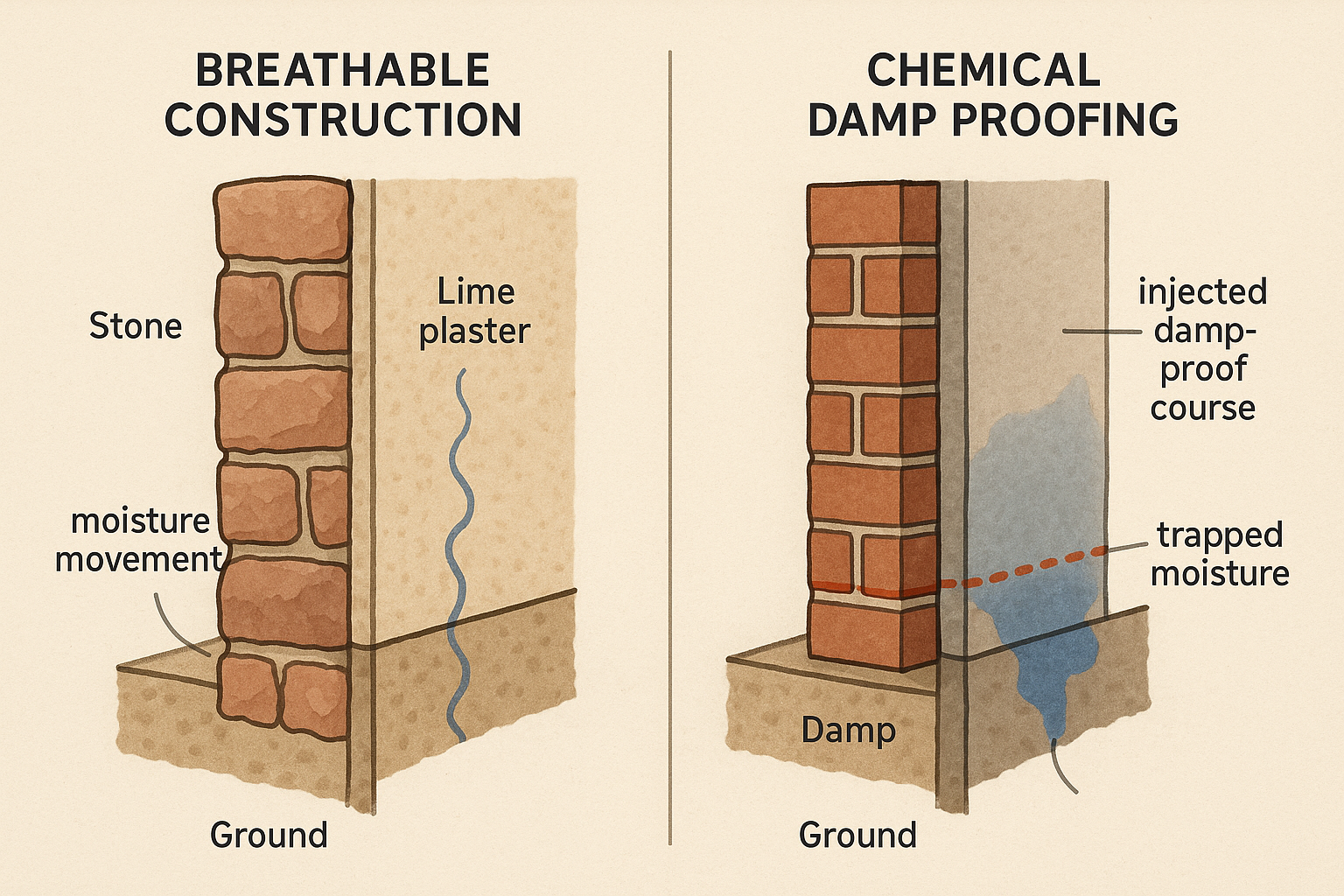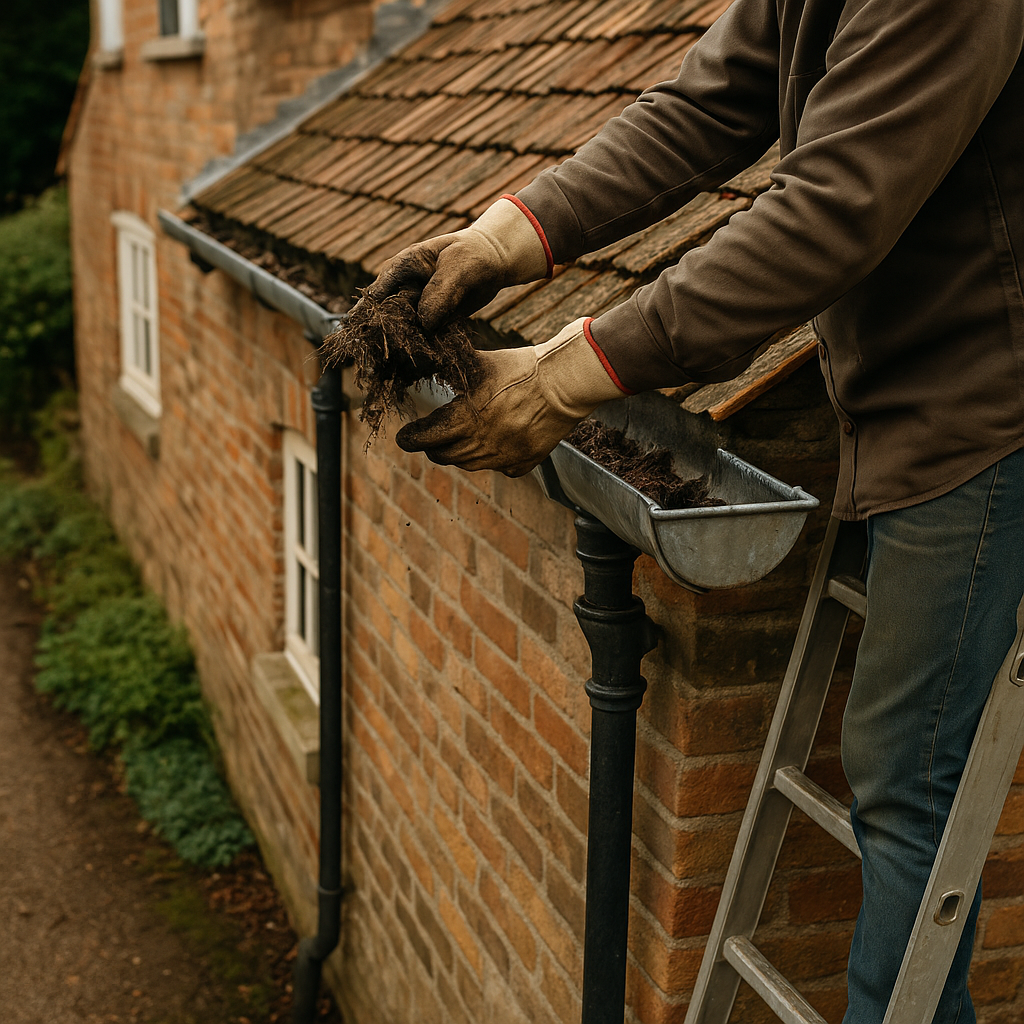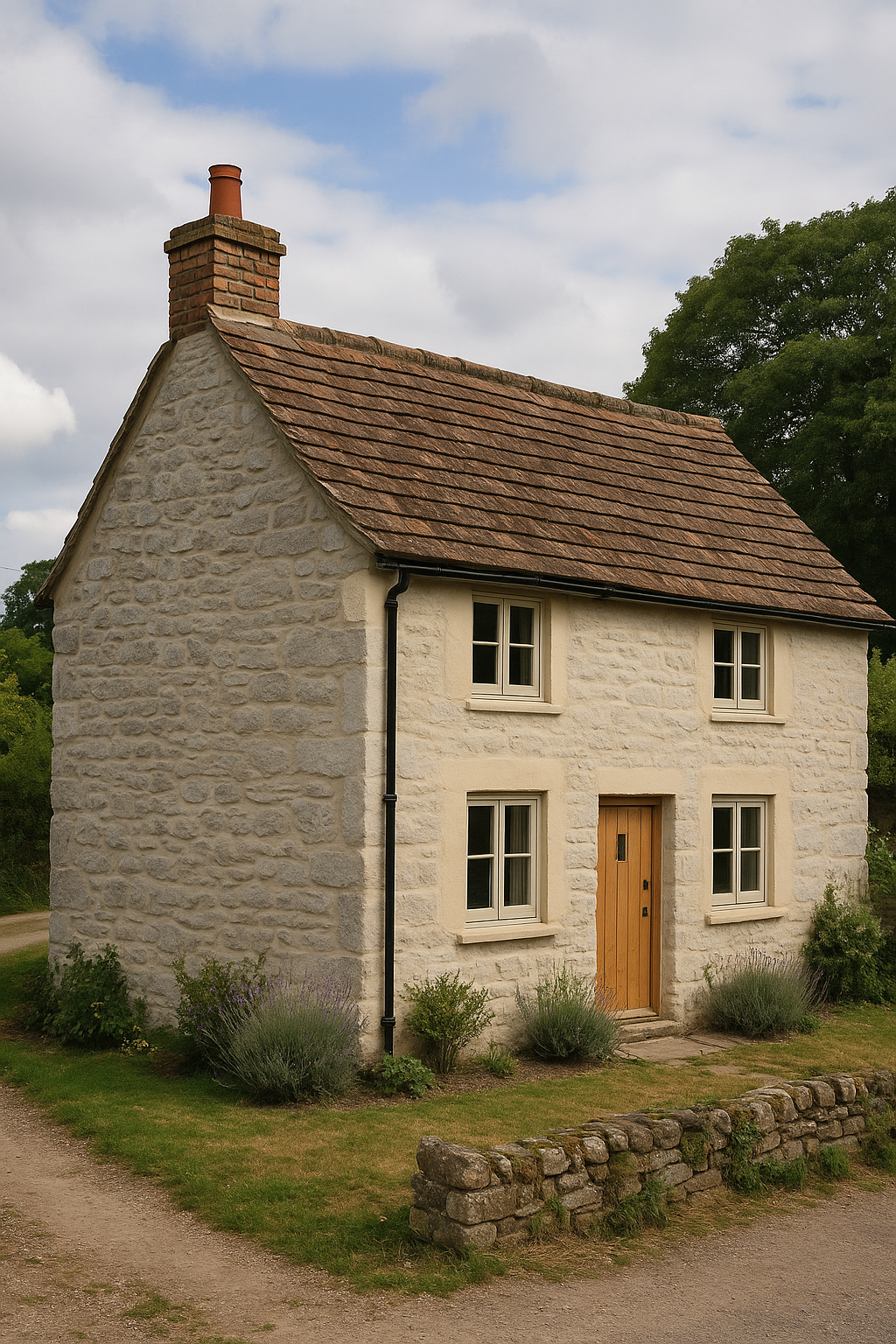Managing Damp in Traditional Homes Flintshire, Chester, Cheshire, and North East Wales
Traditional cottages, townhouses and farmsteads give Flintshire, Chester, Cheshire and North East Wales their distinctive character. Yet their lime mortars, timber frames and solid masonry behave very differently from modern cavity-wall construction. When moisture problems appear, quick-fix chemical injections often make matters worse. A sympathetic, building-led approach keeps historic fabric dry without stripping away the qualities that make these homes special.
This guide explains how damp develops in older buildings, why chemical damp proof courses rarely succeed, and the natural management methods that protect both your property and its heritage value. Whether you own a Victorian terrace in Chester or a rural cottage near Mold, these principles will help you create a healthier living environment.
Understanding Damp in Historic Buildings
Damp is one of the most frequently reported issues in period homes. Recognising how moisture moves through historic materials is the first step towards lasting solutions that respect the property’s fabric.
Why Traditional Homes Behave Differently from Modern Houses
Pre‑1919 buildings typically use breathable materials such as lime mortar, porous stone and soft brick. These components allow moisture to evaporate naturally, balancing internal humidity with external conditions. Modern waterproof coatings, cement renders and injected barriers disrupt that balance by sealing moisture in the wall. The trapped water leads to salt contamination, flaking plaster and decaying timber. Successful damp management therefore relies on maintaining breathability rather than blocking moisture pathways.
Common Signs of Damp in Period Properties
Damp problems often develop gradually. Early intervention prevents costly repairs and protects interior finishes. Look out for:
- Blistering or flaking paint and plaster
- Horizontal tide marks or salt crystals on wall surfaces
- Musty odours in cellars, cupboards and voids
- Condensation on cold external walls or original sash windows
- Timber skirtings, joists or lintels becoming soft, brittle or discoloured
Causes of Damp in Traditional Homes
No single damp problem is the same. Diagnosing the underlying cause ensures you invest in repairs that actually work.
Rising Damp: Myths and Realities
True rising damp—groundwater travelling up through a wall by capillary action—is much rarer than often claimed. Misdiagnosis leads to expensive chemical treatments that fail because the real culprit was a blocked drain, leaking downpipe or internal condensation. Surveyors experienced with heritage buildings focus on the whole moisture profile, not just isolated meter readings.
Penetrating Damp from Weather and Rainfall
Flintshire and Cheshire receive significant rainfall driven by prevailing westerly winds. Saturated external walls, failed pointing or cracked render can allow rain to migrate indoors. Breathable lime pointing and well-maintained limewash encourage moisture to escape again, whereas cement-based finishes trap it in the masonry.
Condensation and Poor Ventilation
Tightly sealed windows, blocked chimneys and modern living habits produce excess humidity. When that moisture meets cold, uninsulated walls it condenses as droplets or black mould. Restoring natural ventilation routes and gently heating rooms reduces the risk without relying on chemical additives or vapour-impermeable paints.
Groundwater and Drainage Issues
High external ground levels, compacted flowerbeds and damaged gullies can direct water against a wall. Over time, this causes persistent damp patches at the base of interior walls. Lowering soil levels, clearing debris from drains and diverting rainwater away from the building break the cycle of saturation.
The Problem with Chemical Damp Proof Courses
Chemical damp proof courses promise a quick fix, yet traditional walls seldom respond well to them. Before committing to injections or waterproof coatings, consider the limitations.

Why They Fail in Traditional Walls
Random stone rubble cores, wide mortar joints and voids make it impossible for chemical injections to create a continuous barrier. Fluids follow the path of least resistance and leave untreated gaps. Moisture simply finds another route, leaving homeowners out of pocket with damp still present.
Potential Damage to Heritage Materials
Injected creams and waterproof slurries seal the surface of lime plaster and stone. As the wall dries unevenly, salts crystallise beneath the hardened layer and force it to delaminate. Timber embedded in walls can also decay faster when moisture becomes trapped around it.
The Cost vs. Effectiveness Debate
Chemical systems often cost thousands of pounds yet rarely address the root cause of moisture. Investing the same budget in roof repairs, drainage improvements and breathable finishes delivers proven, long-term benefits with far less disruption.
Natural and Sympathetic Damp Management Methods
Traditional homes respond best to holistic solutions that work with the building’s fabric rather than against it. The following strategies respect conservation principles while keeping interiors comfortable.
Improving Natural Ventilation
Encourage airflow by unsealing redundant fireplaces, fitting discreet air bricks and ensuring windows can be safely opened. Mechanical extract fans in kitchens and bathrooms should discharge outdoors, not into roof voids. These measures expel humid air before it condenses on cooler surfaces.
Breathable Plasters and Lime Renders
Replace cement-based plasters with lime plaster or hemp-lime mixes that buffer humidity. A breathable finish allows moisture to evaporate evenly, preventing salt blooms and blistering.

Managing Ground Levels and External Drainage
Check that soil, paving and decking sit at least 150mm below internal floor level. Installing land drains or French drains where appropriate keeps foundations drier. Redirect downpipes into soakaways or drainage systems that can handle heavy North Wales rainfall.
Roof, Gutter, and Rainwater Maintenance
Clean gutters twice a year, repair leaking joints and ensure downpipes discharge freely. Replace cracked slates, slipped tiles and defective lead flashing promptly so that penetrating rainwater never reaches the internal structure.

Timber Preservation without Harsh Chemicals
Most fungal decay and wood-boring insects thrive only in damp conditions. By improving ventilation and controlling moisture, you remove the need for aggressive chemical treatments. Use targeted repairs, such as splicing in new timber or applying boron rods, only where structural integrity is compromised.
Case Studies: Damp Solutions in Flintshire and Cheshire
Local projects show how sympathetic methods outperform blanket chemical treatments.
Restoring a Flintshire Cottage
A stone cottage near Mold suffered from saturated walls after decades beneath cement render. Removing the render, re-pointing with lime mortar and reopening the original inglenook fireplace allowed the walls to dry naturally within months.

Chester Townhouse Damp Management
A Georgian townhouse in Chester had been misdiagnosed with rising damp. Instead of injections, the owner lowered external ground levels, repaired cast-iron gutters and replastered with lime. Moisture readings fell steadily over the following year without any chemical intervention.
Rural Cheshire Farmhouse Solutions
On a Nantwich-area farmhouse, new land drains and breathable limecrete floors replaced impermeable concrete. Coupled with controlled ventilation, these upgrades eliminated condensation and preserved the original oak beams.
Preventive Maintenance for Traditional Homes
Routine maintenance keeps moisture at bay and protects valuable materials. Scheduling small tasks throughout the year is far cheaper than tackling extensive damp damage later.
Seasonal Checks and Repairs
Inspect roofs, flashings and rainwater goods every spring and autumn. Clear vegetation away from walls, remove debris from drains and repair pointing before winter storms expose weaknesses.
Regular Monitoring and Moisture Surveys
Track humidity with inexpensive sensors and consider professional moisture surveys when symptoms persist. Independent damp specialists use calibrated instruments to differentiate between surface condensation and deeper structural problems, ensuring any remedial work targets the true cause.
Local Expertise and Conservation Principles
Heritage buildings benefit from guidance tailored to regional climate patterns and traditional construction methods.
Why Local Climate Knowledge Matters
North East Wales experiences driving rain and prevailing winds that can overwhelm generic damp solutions. Local specialists understand how weather patterns affect exposed gables, chimneys and valley gutters, enabling them to specify durable, site-specific repairs.
Heritage Building Specialists in North East Wales
Conservation-accredited surveyors, lime plasterers and joiners across the region provide sympathetic services. Their expertise ensures repairs comply with planning requirements and safeguard the historic significance of your property.
FAQs on Managing Damp in Traditional Homes
Is rising damp real in old houses?
True rising damp can occur but is rare. Most cases labelled as rising damp stem from defective maintenance, high external ground levels or condensation. Independent surveys help confirm the real cause before you invest in treatments.
Should I use a chemical damp proof course in my period property?
Chemical damp proof courses are seldom compatible with breathable walls and can trap moisture inside. It is better to address ventilation, drainage and material compatibility first.
What’s the best plaster for damp walls?
Lime plaster is the preferred option for traditional buildings. Its vapour permeability allows walls to dry evenly, preventing salt damage and blistering paint.
How can I stop condensation in a cottage?
Increase ventilation by opening windows, reinstating air bricks and keeping chimneys ventilated. Combine these steps with balanced heating and extractor fans that vent outside.
Are dehumidifiers a good solution?
Dehumidifiers provide short-term relief but do not remove the source of moisture. Use them alongside structural repairs and ventilation improvements rather than as a standalone cure.
How often should I check gutters and roofs?
Inspect gutters, downpipes and roof coverings at least twice a year—typically in spring and autumn—and after severe storms to ensure rainwater is safely diverted away from the building.
Conclusion: A Healthier Approach to Damp in Historic Homes
Managing damp in traditional homes across Flintshire, Chester, Cheshire and North East Wales means working with the building, not against it. By prioritising breathable materials, effective drainage and good ventilation, you can protect both the structure and the wellbeing of its occupants without resorting to invasive chemical treatments.
For conservation-led support, explore our dedicated damp survey service, damp & mould surveys and timber investigations, or call 07378 732037 to speak with a surveyor.
Continue planning with our ventilation assessments, see when a RICS Level 3 Building Survey is the right choice for heritage refurbishments, and dive deeper into our guide to preserving traditional architecture.
